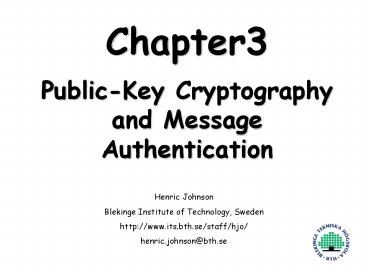PublicKey Cryptography and Message Authentication - PowerPoint PPT Presentation
Title:
PublicKey Cryptography and Message Authentication
Description:
2. Contents have not been altered, 3. Sometimes, it was sent at ... An authentication tag is generated and appended to each message. Message Authentication Code ... – PowerPoint PPT presentation
Number of Views:137
Avg rating:3.0/5.0
Title: PublicKey Cryptography and Message Authentication
1
Chapter3
- Public-Key Cryptography and Message Authentication
Henric Johnson Blekinge Institute of Technology,
Sweden http//www.its.bth.se/staff/hjo/ henric.joh
nson_at_bth.se
2
OUTLINE
- Approaches to Message Authentication
- Secure Hash Functions and HMAC
- Public-Key Cryptography Principles
- Public-Key Cryptography Algorithms
- Digital Signatures
- Key Management
3
Authentication
- Requirements - must be able to verify that
- 1. Message came from apparent source or
author, - 2. Contents have not been altered,
- 3. Sometimes, it was sent at a certain time or
sequence. - Protection against active attack (falsification
of data and transactions)
4
Approaches to Message Authentication
- Authentication Using Conventional Encryption
- Only the sender and receiver should share a key
- Message Authentication without Message Encryption
- An authentication tag is generated and appended
to each message - Message Authentication Code
- Calculate the MAC as a function of the message
and the key. MAC F(K, M)
5
(No Transcript)
6
One-way HASH function
7
One-way HASH function
- Secret value is added before the hash and removed
before transmission.
8
Secure HASH Functions
- Purpose of the HASH function is to produce a
fingerprint. - Properties of a HASH function H
- H can be applied to a block of data at any size
- H produces a fixed length output
- H(x) is easy to compute for any given x.
- For any given block x, it is computationally
infeasible to find x such that H(x) h - For any given block x, it is computationally
infeasible to find with H(y) H(x). - It is computationally infeasible to find any pair
(x, y) such that H(x) H(y)
9
Simple Hash Function
- One-bit circular shift on the hash value after
each block is processed would improve
10
Message Digest Generation Using SHA-1
11
SHA-1 Processing of single 512-Bit Block
12
Other Secure HASH functions
13
HMAC
- Use a MAC derived from a cryptographic hash code,
such as SHA-1. - Motivations
- Cryptographic hash functions executes faster in
software than encryptoin algorithms such as DES - Library code for cryptographic hash functions is
widely available - No export restrictions from the US
14
HMAC Structure
15
Public-Key Cryptography Principles
- The use of two keys has consequences in key
distribution, confidentiality and authentication. - The scheme has six ingredients (see Figure 3.7)
- Plaintext
- Encryption algorithm
- Public and private key
- Ciphertext
- Decryption algorithm
16
Encryption using Public-Key system
17
Authentication using Public-Key System
18
Applications for Public-Key Cryptosystems
- Three categories
- Encryption/decryption The sender encrypts a
message with the recipients public key. - Digital signature The sender signs a message
with its private key. - Key echange Two sides cooperate two exhange a
session key.
19
Requirements for Public-Key Cryptography
- Computationally easy for a party B to generate a
pair (public key KUb, private key KRb) - Easy for sender to generate ciphertext
- Easy for the receiver to decrypt ciphertect using
private key
20
Requirements for Public-Key Cryptography
- Computationally infeasible to determine private
key (KRb) knowing public key (KUb) - Computationally infeasible to recover message M,
knowing KUb and ciphertext C - Either of the two keys can be used for
encryption, with the other used for decryption
21
Public-Key Cryptographic Algorithms
- RSA and Diffie-Hellman
- RSA - Ron Rives, Adi Shamir and Len Adleman at
MIT, in 1977. - RSA is a block cipher
- The most widely implemented
- Diffie-Hellman
- Echange a secret key securely
- Compute discrete logarithms
22
The RSA Algorithm Key Generation
- Select p,q p and q both prime
- Calculate n p x q
- Calculate
- Select integer e
- Calculate d
- Public Key KU e,n
- Private key KR d,n
23
Example of RSA Algorithm
24
The RSA Algorithm - Encryption
- Plaintext Mltn
- Ciphertext C Me (mod n)
25
The RSA Algorithm - Decryption
- Ciphertext C
- Plaintext M Cd (mod n)
26
Diffie-Hellman Key Echange
27
Other Public-Key Cryptographic Algorithms
- Digital Signature Standard (DSS)
- Makes use of the SHA-1
- Not for encryption or key echange
- Elliptic-Curve Cryptography (ECC)
- Good for smaller bit size
- Low confidence level, compared with RSA
- Very complex
28
Key ManagementPublic-Key Certificate Use































